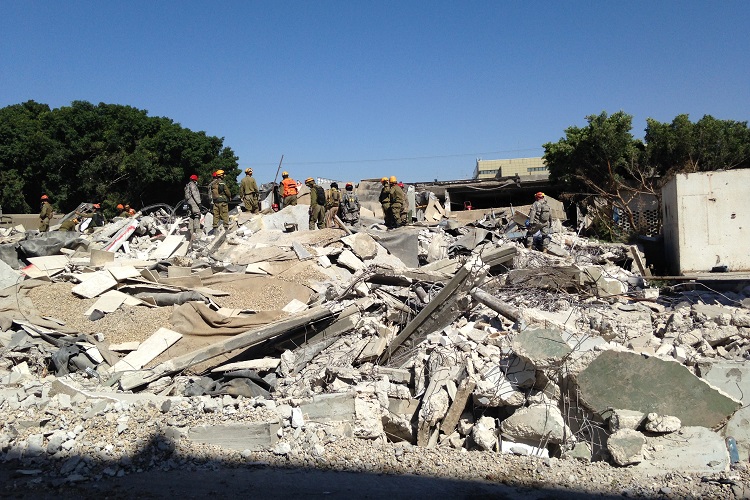
By Stephen Coover
In June 2013, the Bloomington (IN) Fire Department (BFD) participated in an event called United Front in its town. The United Front exercise is an ongoing military Small Unit Exchange Exercise between the Israeli Home Front Command (HFC); National Rescue Unit; and the Indiana National Guard’s 19th Chemical, Biological, Radiological, Nuclear, and High-Yield Explosives (CBRN)—Enhanced Response Force Package (CERFP). This partnership began in 2012 and provides reciprocal support between the Indiana National Guard CERFP and the Israeli HFC. In the past, Israeli HFC have hosted training operations for Indiana Guardsmen. In return, Indiana Guardsmen have hosted similar exercises for Israeli HFC with a focus on disaster response.

In 2013, the program evolved to include additional local and state organizations. Local representation consisted of the BFD, and state organizations were represented by the Indiana Department of Homeland Security in addition to Indiana Task Force 1.
The exercise was a success because it met all the objectives of sharing techniques of search and rescue extraction and information regarding large-scale disaster response command structure. In 2014, I was invited to Tel Aviv, Israel, to participate in a similar drill to continue the collaboration. In 2015, the drill was held in the Muscatatuck Urban Training Center in Butlerville, Indiana. This year, I was invited to participate and was flown to Lod, Israel, to continue the training collaboration we have shared for the past four years.
RELATED: Vernon on Strategies for Surviving the IED Response ‖ Kreutzer on Hazmat: Initial Actions and Chemical Assessment ‖ Stilp and Bevelacqua on the Dangers of Hydrogen-Based Experimental Fuels
Exercise Scenario
The exercise consisted of a scenario involving a terrorist attack on two buildings in close proximity to each other. The main building was a three-story building; the first floor was a parking garage, the second floor was an open dining/cafeteria area with kitchen, and the third floor was office space. The alternate building was a single story with a partial basement supermarket. The main three-story building was imploded, and the alternate building containing the supermarket was demolished with heavy equipment.
The exercise began on June 21, 2016, at 0900 hours. Approximately 60 minutes into the drill, an unexploded ordinance that had failed to detonate during the implosion was found. The demolitions contractor had reported that all devices had a secondary detonator as a “fail-safe” backup to ensure all explosives would discharge, which unfortunately was not the case. The evacuation notification was communicated, and all members left the area.

The Israeli Police bomb squad was notified, removed the ordinance, and swept the building with an explosive detection canine. Initially, this event was considered a failure because of the discovery of an unexploded ordinance. Often times, it is not until a real emergency where you can obtain critical time-framed information. For example, years ago, I had received high-rise training from the Chicago (IL) Fire Department. The captain asked the class, “Do you know how long it takes to evacuate a 42-story apartment building?” No one in the class had an answer, so he said, “Neither did I until we arrived with the 4th floor on fire, impinging to the 5th, and needed to evacuate it. It takes an hour.”
In this case, a sweep of an intact three-story building with this layout would take an explosive detection canine approximately one hour to complete. When the building was collapsed, the search now took two to three hours, not including the response time of the unit. In past exercises, the “look or be aware of secondary devises” is commonly verbally acknowledged; the discovery of the unexploded ordinance was an unintended learning experience that can be implemented in real-world events, should they occur. This now means an increased time ratio of 4:1 should be applied when responding to a collapsed structure that is in need of an explosive detection canine sweep for secondary devises. This will allow for the sweep by the explosives detection canine as well as the restart of the rescue activities to include an updated safety briefing.

I explained to members of the command staff how important this information was for the operations of a real-world event. I recommended that this information be included in the postincident analysis on the positives and the negatives of the exercise. The positive aspect is the time needed to determine secondary devices. The negative is that, when imploding a building for training, the collapsed building must be swept with an explosive detection canine prior to execution of the disaster drill.
Too often, we do not determine the actual time of real-world events and find ourselves in a position of the unknown, the consequences of which can be catastrophic. The information learned about the time necessary to mitigate an incident involving secondary devices or the failure of detonation should promote a review of our current strategies. Although most strategies depend on the conditions, actions, and needs as well as available resources, consider implementing a plan that addresses the time and staffing required to mitigate a scenario involving a secondary device with the information included in briefings as you prepare for such an event.
Stephen Coover is a battalion chief with the Bloomington (IN) Fire Department. He is a graduate of Indiana University and of the Executive Fire Officer Program at the National Fire Academy. Additionally, he is an instructor for the United State Fire Administration’s National Fire Academy and the Indiana Department of Homeland Security and is an adjunct instructor for Ivy Tech Community College and for the local technical career center. He has been a speaker at the Fire Department Instructors Conference International. Since June 2013, Coover has received focused specialized training from the Israeli Homefront Command National Rescue Unit.


